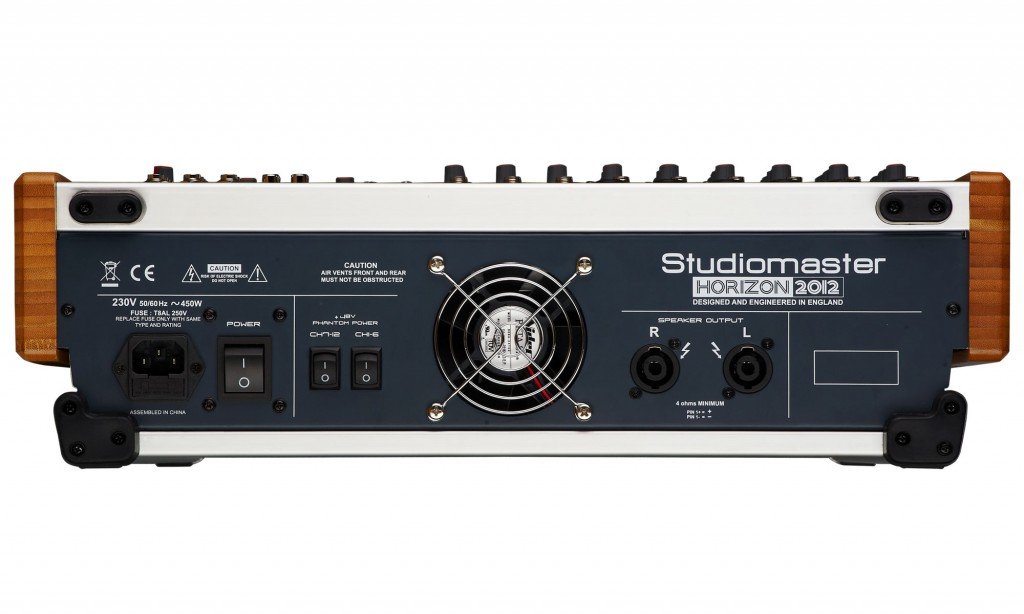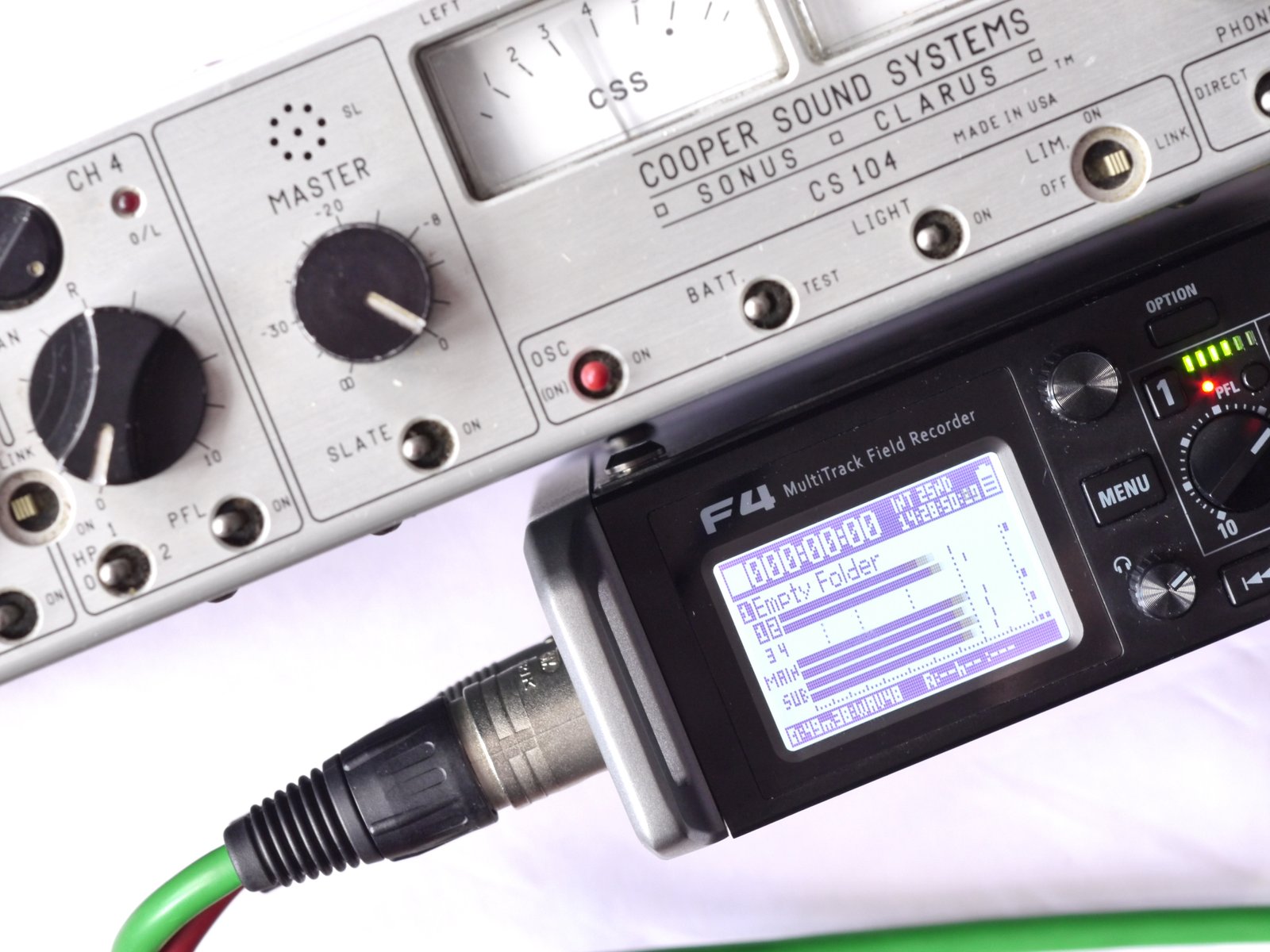
1 Intro
There are three places you can stick your power amp, well four if you include the anatomically
impossible suggestion of your long suffering neighbours. First, in it’s own heavy duty box
with big rack handles and more fins than Helsinki or maybe put it in your speaker, go active,
or put it in with the mixing desk and embrace the powered mixer route. Which is the noble
path long trodden by Studiomaster. New from them in 2013 is the 2012, sounds like it might
be a year late but in fact is a twelve channel mixer with two kilo watts of on board power
or just under three horse power. Sadly I didn’t have any horses on hand to check the specs.
The twelve channels are presented on nine faders, which is the number of mic amps in the
desk. The last three channels double as stereo line inputs so to get the full twelve channel
Horizon experience you need six mono mic or line inputs and three stereo line inputs.
2 Covering the bases
The ‘all in one mixer’, is quite a tough task to pull off these days because the definition of
‘all’ just keeps getting bigger. We want eq on every channel, including the stereos. We want
some dynamics for our vocal mics, we want some effects — reverb and delay and what have
you, we want to some eq for the room, we want some computer interfacibility, inserts for
outboard procesing and a couple of Aux sends for monitors. Maybe a seperate send for a
sub when we have a bit more cash to spend. We want it all. And Studiomaster have made a
stab at providing all of this and all in a well screwed together package in a tidy box. Bamboo
cheeks and aluminium end plates leading the way.
2.1 Power and Loudness

One of the first questions you ask when you stick an amp in your mixer is. ‘How loud is it?’
And the answer is, not loud at all. The variable speed fan is not going to bother you unless
you are recording a harp and triangle gig and you have only brought two meter xlrs. Oh I
see, ‘How loud is it?’ Well three horse power is not to be sneezed at. I strapped a couple
of 500 watt eight ohm cabs across the output and wound it up. In a smaller club room I
easily managed 105dB at about five meters. Watts being notoriously slippy in the real world
I’d say quite loud enough for most small PA jobs. I had an old and much abused Yamaha
power amp to hand and the Horizon easily bested it in terms of sound quality which is not
too shabby for a built in amp at that. And I think the Yamaha is heavier than the entire
Studiomaster mix/amp package. In fact the Horizon doesn’t seem heavy enough to hold all
1
those watts. It turns out that the Studiomaster features a class G amplifier — which Audio
Media regulars will know is easily confusable with class H. However if you know someone
who can describe the difference I would avoid them, especially on long journeys where it
can be hard to get away without seeming rude. The power is available on Neutrik Speakons
which are industry standard and a thoroughly good thing.
2.2 Inputs and Features
Returning to the other end of the signal path the Horizon’s mic amps offer a claimed 60dB
of gain and in comparison with some nice Swiss mic preamplitude they were not disgraced.
Neither was noise a problem at higher gains. The first three channels feature VMS —
that being a dynamic processor or ‘Vocal Management System’. It’s undoubtedly handy to
have three individual compressors on board, they did the job, I wouldn’t say they were my
favourite part of the desk but they are there if you need them. I would have liked a limiter
on the output but then I’m a very needy person. The eq is basic, an lf filter followed by
fixed frequencey high and low controls and a swept mid. You also get eq on your two Aux
masters, though the high and low sections are shelving rather than center frequency based.
You also get a sweepable notch filter to hack out those tricky feedback causing frequencies.
To ice the cake you get digital DSP engines, each with eight settings, mostly reverbs and
plates and also a variable delay. The reverbs are all fixed effects with the only control being
the wet/dry balance. While being a very simple system, it is probably all you need for a
small PA gig and the reverbs sound perfectly usable. The DSP output can also be fed into
the Aux sends if you want to provide your vocalist with some reverb in their monitors for
instance.
2.3 Back to the outputs.
And so back to the outputs. The 2012 has a nine band graphic eq with plus or minus nine
dBs on each frequency, it also has a built in 100Hz crossover which can drive a Mix2 output
for seperate subs, the normal output carrying the signal from 100Hz up. There is some
control of the amp output with a switch offering 100%, 40% and 15% power output options.
Measuring with programme, the 40% is about five or six dB below main output and the
15% another three dB below that. And finally you can split the outputs for monitor mixes,
either having a mono main on the right hand channel with Aux 1 feeding the left hand amp
or the amps being fed from Aux 1 and Aux 2 while the main output is available on the xlrs
to drive an external amp or bigger PA system.
2.4 Expect The Best
The Studiomaster catchline is ‘Expect the Best’ — which would be silly if applied to indi-
vidual components of the mixer — you can’t have the best mixer in the world with 60mm
faders, but maybe the claim is not so off the mark when applied to the package. It is well
made honest gear. From USB playback for your walk in music to the comprehensive output
options you really do have everything you need in one box to do a small PA gig. And in a
well thought out package. When pinched I have done a few PA gigs on MI gear, we all have
and how we hated it. The Studiomaster is a ‘gig in a box’ done properly. Did I mention the
cool led light strip at the top of the mixer? It’s cool.
2
